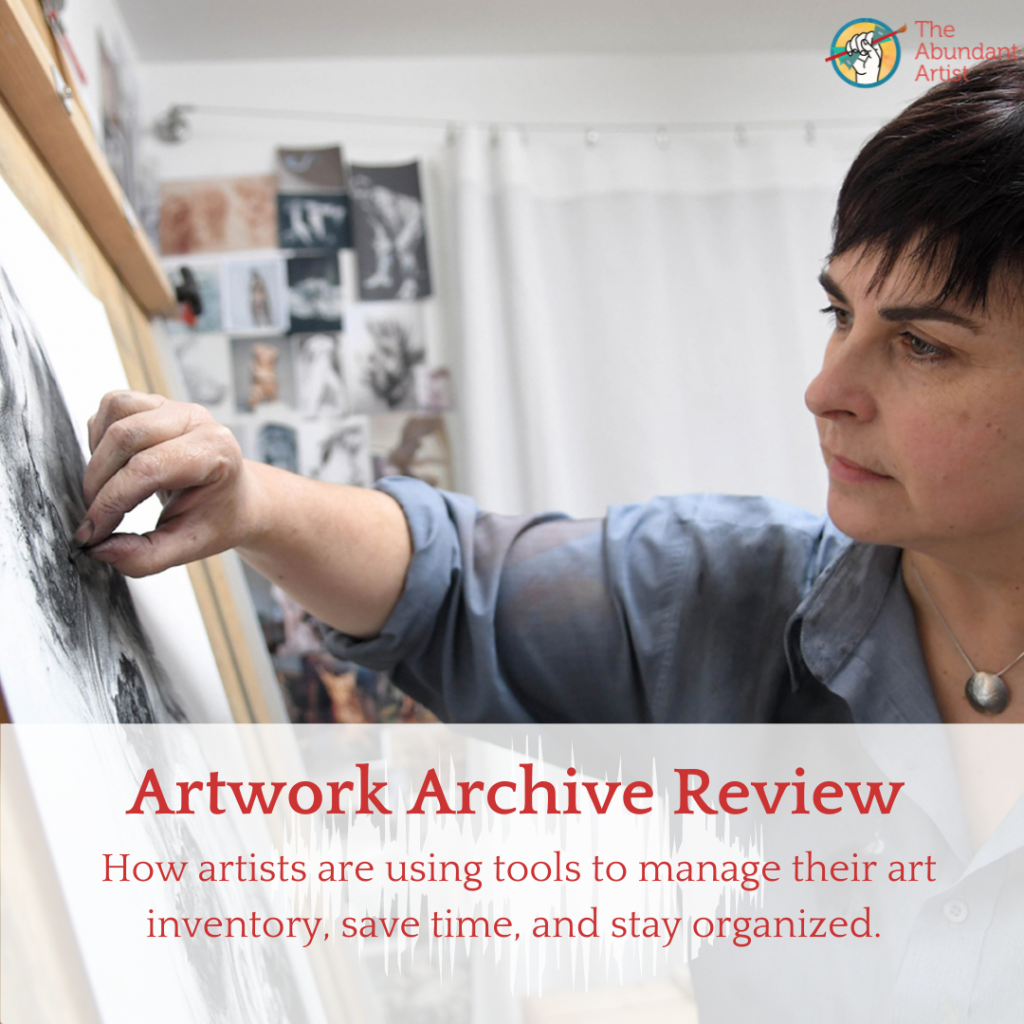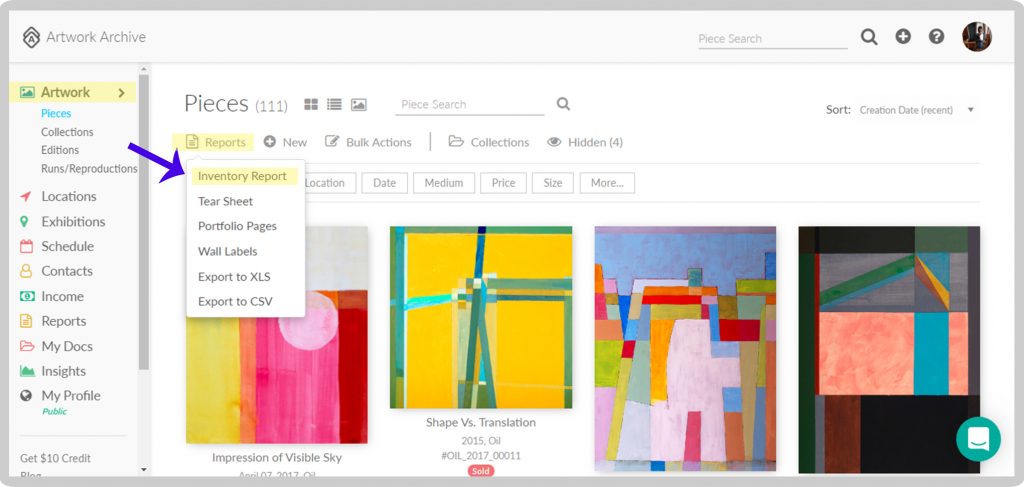Imagine you are a prolific artist who has created hundreds of paintings and sculptures. You have sold hundreds of pieces and they have moved around the world, displayed in private and public collections. You also have pieces in museums and on display in various galleries, coffee shops, boutiques, and other places. Maybe you even have a few pieces that are licensed to major retailers.
How do you keep track of all of that?

Some artists do it with spreadsheets. That quickly becomes cumbersome and requires quite a bit of manual updating, and still leaves a lot of work to be done when it comes to labeling, creating certificates of authenticity and other routine activities for artists.
Many companies have attempted to create better tools, and we’ve reviewed several of them. We’ve reviewed Artwork Archive before but it’s been a few years. I recently reconnected with their team to get an update on their platform.
Sign up for Artwork Archive here*.
What is Artwork Archive?
In their own words, ”Artwork Archive provides artists, collectors and organizations
powerful tools to manage their artwork, career or collection.” Those tools include one place to input images, dimensions, weight, location, creation date, medium, price, and more information about your art.
That data can then be used to create collections, track reproductions, and create private collections that can only be viewed by specific collectors or licensing buyers.
You can also track the provenance of each piece, including not just the creation date, but also any exhibitions and who has purchased the work. This information can be used to generate certificates of authenticity or simply sent to buyers and curators so they have a history of the work.
This one place to put all your data solution is common enough, but the consistent feedback we received from artists was that there are two features that set Artwork Archive apart: collections and inventory reports.
Private & Embedded Collections
Collections of art are easy to organize in Artwork Archive. That’s the core function after all. Artwork Archive allows you to take this to the next level by publishing those collections to the web, either publicly or privately with a password requirement.
Public collections can be used to show what’s available, what’s sold, what’s on display at a museum, or any other combination. Private collections would be used (for example) to show a collection of works available for licensing or to show works in progress to give your most important collectors early access. Public and private collections can be embedded on websites with a simple copy & paste HTML snippet.
Inventory Reports & Tear Sheets
If you’ve ever gotten ready for an exhibition and realized you need to create info sheets for each work on display you know the pain of having to hand write or retype that sheet. With AA you can just find the work, click a button and print a tear sheet with the selected info on it for everything that’s for sale.

And just in case you were wondering if it’s going to be a nightmare to transition from your existing spreadsheet to Artwork Archive, there is a bulk uploading feature.
There’s a lot of features built into that monthly subscription (currently $8 – $24 per month, depending on the plan level). We won’t touch on all of those features here as you can easily read the list on their website. Instead here we will focus on how artists are actually using the platform.
How Artists Actually Use Artwork Archive
We asked artists who use Artwork Archive the following questions:
- What made you realize you needed to get your inventory organized?
- What do you like about Artwork Archive?
- What about the platform needs work, or what do you wish it did?
Below we’ve shared selections of some of the most useful feedback from artists.
What made you realize you needed to get your inventory organized?
Early in their career, many artists don’t even bother to create an inventory of their work. It’s overwhelming enough to just make and sell the work. Most of us don’t think about our legacy or estate until much later in life, which means that creating an art inventory can feel overwhelming.
Tansy Lee shared a common story about preparing for an exhibition, “I was selecting and packing work to send to an exhibition. I needed about 6 pieces and had an idea in my mind which ones they should be, but I was struggling to find one charcoal work in particular. I had the images I needed in my digital catalogue but just couldn’t find the actual artwork. Frustrated, I searched my studio for an hour or more, had some cups of tea while trying to remember it, looked everywhere in the house and felt very annoyed at my own inefficiency. Eventually it dawned on me that I had actually sold it 3 years before and it now lived in Manchester!
This made me see I was going to need a better system if I had any hope of keeping track of my work – after 10 years of making, my cobbled together process of documenting work was no longer up to the job. I realised that I would need a much more reliable and professional system to support my art making, ideally one which saved me time spent on the tedious admin tasks we have to do to sustain our practice.”
What do you like about Artwork Archive?
Tania Hillion said, “First thing first, it does a great job to archive my artworks with multiple photos references, video links, categories for sizes, automatically making the conversion from inches to cm…these are small things but when you are seeking for a specific info, it is gold to have a quick and easy access to these data.”
She went on to explain, “On Artwork Archive I create as many ‘collections’ or artworks, that can be translated to groups of artworks that I want to display indifferent categories. Then the tool gives me a little piece of html code that I just need to copy/paste on my wordpress website to display the selection(s) on my website.”
That means any time you update info in your inventory (like a new museum or private collection location), it’s automatically updated anywhere your art is public.
Several artists also prased the invoicing feature built into Artwork Archive*. With all of the art info already there, it’s easy to enter collector info and send them an invoice. When they pay, your collection is updated and you have a central location to keep info on your collectors. Artwork Archive acts as a Customer Relationship Management database, showing you who has what works, when they were purchased, and other important information.
You can also leverage all of this information to create private collections for things like commission works in progress or works available for licensing, where collectors and art buyers can make comments.
What about the platform needs work, or what do you wish it did?
The public collections feature is popular but many artists pointed out that it is not a substitute for a website. There’s not a built-in ecommerce feature like Shopify or Woocommerce. If you plan to make a significant effort to sell art online, you’ll need something in addition to Artwork Archive, which means managing two different inventory systems.
The CRM system (contact management) is fairly minimal and doesn’t include some key features that would put it on par with something like Salesforce or Zoho. The biggest missing feature is email integration. In most CRMs you can add an email to your BCC line that copies the email response into your CRM so you can view your communication history in your CRM, but that’s not possible with Artwork Archive.
Neither of these things take away from Artwork Archive’s primary function: being a great inventory management system. I would hope to see some level of integration with common shopping solutions in the future, but integrations like that are expensive and time consuming to maintain and are typically only built by much larger companies.
Featured Artist Bios & Art
Many artists gave input for this article, but special thanks go out to two particular artists for sharing detailed feedback.

Tania Hillion is a French artist based in Quebec (Canada) who uses oil painting as the predominant medium to address the notion of perceptual memory. Figurative portrait painter, she is self-taught. Website.

Tansy Lee Moir is inspired by the forms and stories of old trees, by the way humans, animals and natural processes have shaped them. It encourages us to look at trees in new ways and to think about our ancient, layered relationships with them as living organisms. Website.
Should You Use Artwork Archive?
Hopefully this review gives you an idea of what you can do with Artwork Archive*. If you are early in your career we highly recommend you keep an inventory of your work, even if you’re not paying for a product yet. We think Artwork Archive offers an organizational framework that is the best in the market and adds some useful tools on top of that.
If you’ve created more than 50 pieces of art and are actively selling your art regularly, Artwork Archive is going to make your life easier, save you time, and help you make more money.
* = Affiliate Link. TAA may receive a small commission if you sign up for Artwork Archive. We only recommend products that we think are great for artists.
Leave a Reply